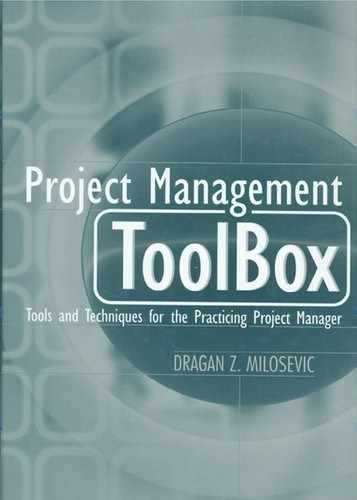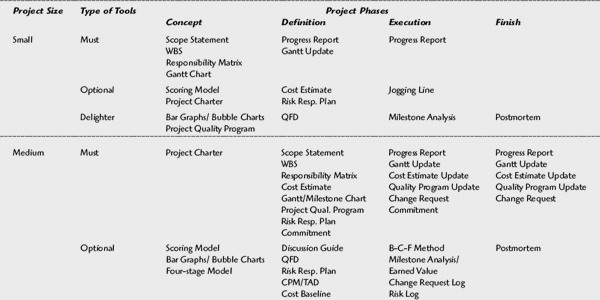B
Project Management Toolboxes per Project Size
As discussed in Chapter 16, the customization of the project management (PM) toolbox by project size is the right option when an organization has projects of varying size with mature technologies. Here, we provide examples of toolboxes for such option with the following goals:
- Goal 1: Tier PM toolbox per project size
- Goal 2: Tier each size's toolbox into more and less important tools
Goal 1: Tier the Toolbox per Project Size
A simple typology of projects by their project size—small, medium-sized, and large projects—is a convenient and well-accepted framework by organizations to reflect on different management needs of their project man-agers. Following this logic, in the tables that follow, we built examples of
- PM toolbox for small projects
- PM toolbox for medium-sized projects
- PM toolbox for large projects
Since the size is the only criterion in building the toolboxes, note that our examples are non-project family/industry/type specific. Also, because size means different things to different organizations, we chose the generic labels of small, medium, and large without specific criteria. For this reasons, you may choose to adapt our examples per your own definition of project size.
Goal 2: Tier Each Size's Toolbox into More and Less Important Tools
To project practitioners all PM tools are not created equal. Some are more, others less important in accomplishing their project goals. Acknowledging this reality and using Kano methodology, the PM toolbox for each size is divided into the following:
- Must tools
- Optional tools
- Delighter tools
Must tools, the first tier, are crucial for a project process to be successful, and if they are not present in the project process, there is a significant likelihood for the project to go wrong. Unlike them, tools in the second tier—optional tools—are not required, although their use may offer project managers more choices and satisfaction. The delighter tools, the third tier, are not even expected to be seen in the project process. Their application, however, may create a special value, which may delight project managers and lead to higher quality of the standardized project management (SPM) process. The hope is that this approach will help project managers be flexible in using the tools. Since we advocate the use of the toolbox as a support for SPM process, note that for the sake of simplicity, only the PM tools are shown, leaving out technical deliverables.


